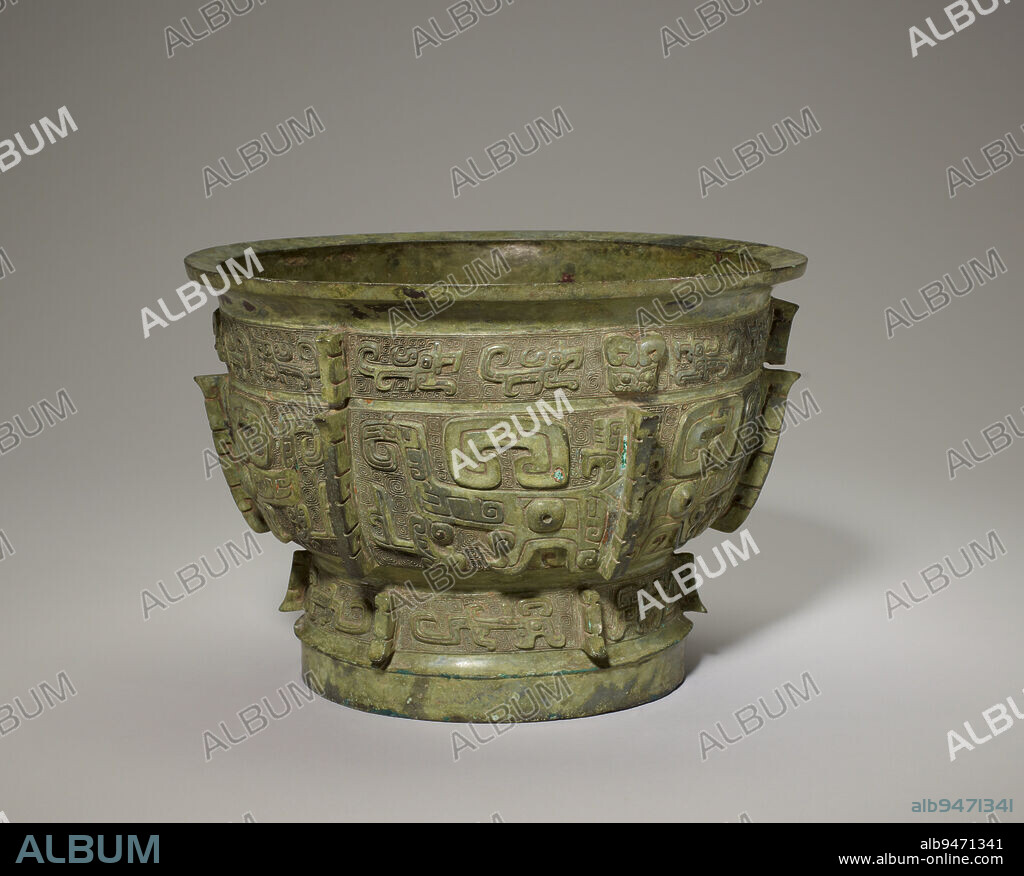alb9471341
Gui food vessel, 12th century BCE, 7 × 9 15/16 in., 8.8 lb. (17.8 × 25.3 cm, 4 kg), Bronze, China, 12th century BCE, Stylized animal motifs predominate Shang bronze decoration. The dragon, snake, cicada, ram, owl, tiger, and even elephant all make appearances. Yet these creatures were almost always less important than the taotie (composite animal) mask, which typically dominates the largest or most important register of nearly all Shang bronzes. This exquisite food bowl, an early form of the gui with looped handles that became prevalent particularly in the Western Zhou dynasty, has three such masks clearly cast in high relief encircling its cauldron. Below each mask, in the foot band, are two opposing dragons shown in profile, while four similar dragons appear above each mask in the top decorative band. The exact meaning of the taotie mask is unknown. A nine-character inscription cast on the interior bottom may stand for branches of a big clan.

|
Ajouter à une autre Lightbox |
|
Ajouter à une autre Lightbox |



Avez-vous déjà un compte? S'identifier
Vous n'avez pas de compte ? S'inscrire
Acheter cette image

Légende:
Voir la traduction automatique
Gui food vessel, 12th century BCE, 7 × 9 15/16 in., 8.8 lb. (17.8 × 25.3 cm, 4 kg), Bronze, China, 12th century BCE, Stylized animal motifs predominate Shang bronze decoration. The dragon, snake, cicada, ram, owl, tiger, and even elephant all make appearances. Yet these creatures were almost always less important than the taotie (composite animal) mask, which typically dominates the largest or most important register of nearly all Shang bronzes. This exquisite food bowl, an early form of the gui with looped handles that became prevalent particularly in the Western Zhou dynasty, has three such masks clearly cast in high relief encircling its cauldron. Below each mask, in the foot band, are two opposing dragons shown in profile, while four similar dragons appear above each mask in the top decorative band. The exact meaning of the taotie mask is unknown. A nine-character inscription cast on the interior bottom may stand for branches of a big clan.
Crédit:
Album / quintlox
Autorisations:
Modèle: Non - Propriété: Non
Questions sur les droits?
Questions sur les droits?
Taille de l'image:
6557 x 5270 px | 98.9 MB
Taille d'impression:
55.5 x 44.6 cm | 21.9 x 17.6 in (300 dpi)
Mots clés:
ANIMAL: BELIER • ANIMAL: SERPENT • BELIER (ANIMAL) • BELIER • BRANCHAGE • BRANCHE • BRONZE • BRONZES • CHINE • CHOUETTE • CHOUETTES • CIGALE • HIBOU • MASQUE • MASQUÉE • MATERIAU BRONZE • OISEAU: CHOUETTE • PROFIL • PROFILS • QUATRE • REPTILE SERPENT • SERPENT • TIGRE • TROIS
 Pinterest
Pinterest Twitter
Twitter Facebook
Facebook Copier le lien
Copier le lien Email
Email
